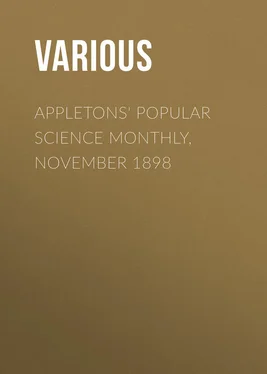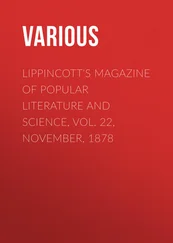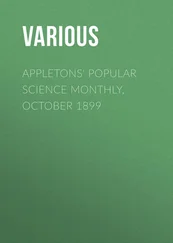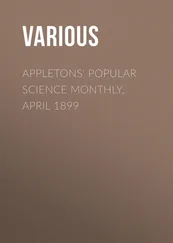Various - Appletons' Popular Science Monthly, November 1898
Здесь есть возможность читать онлайн «Various - Appletons' Popular Science Monthly, November 1898» — ознакомительный отрывок электронной книги совершенно бесплатно, а после прочтения отрывка купить полную версию. В некоторых случаях можно слушать аудио, скачать через торрент в формате fb2 и присутствует краткое содержание. Издательство: Иностранный паблик, Жанр: periodic, foreign_edu, на английском языке. Описание произведения, (предисловие) а так же отзывы посетителей доступны на портале библиотеки ЛибКат.
- Название:Appletons' Popular Science Monthly, November 1898
- Автор:
- Издательство:Иностранный паблик
- Жанр:
- Год:неизвестен
- ISBN:нет данных
- Рейтинг книги:5 / 5. Голосов: 1
-
Избранное:Добавить в избранное
- Отзывы:
-
Ваша оценка:
- 100
- 1
- 2
- 3
- 4
- 5
Appletons' Popular Science Monthly, November 1898: краткое содержание, описание и аннотация
Предлагаем к чтению аннотацию, описание, краткое содержание или предисловие (зависит от того, что написал сам автор книги «Appletons' Popular Science Monthly, November 1898»). Если вы не нашли необходимую информацию о книге — напишите в комментариях, мы постараемся отыскать её.
Appletons' Popular Science Monthly, November 1898 — читать онлайн ознакомительный отрывок
Ниже представлен текст книги, разбитый по страницам. Система сохранения места последней прочитанной страницы, позволяет с удобством читать онлайн бесплатно книгу «Appletons' Popular Science Monthly, November 1898», без необходимости каждый раз заново искать на чём Вы остановились. Поставьте закладку, и сможете в любой момент перейти на страницу, на которой закончили чтение.
Интервал:
Закладка:
In China, Korea, and Japan the sandal has a bifurcated toe cord, the base of which, springing from the front of the sandal, passes between the first and second toes. It belongs to the Old World through its entire extent. It is the only form represented in ancient Egyptian, Assyrian, and Greek sculpture. One would have expected that with any close contact with Asian people this method of holding the sandal to the foot would have been established in Central America, yet one may seek in vain for the evidences of even a sporadic introduction of this method. Where representations are given in the sculptured stone pottery, or codex, the sandal is represented with two cords, one passing between the first and second and the other between the third and fourth toes. Dr. Otis T. Mason, who has given us an exhaustive monograph of the foot gear of the world, says that every authority on Mexico and Central America pictures the sandal with two cords, and he further says, in a general article on the same subject, "An examination of any collection of pottery of middle America reveals the fact at once, if the human foot is portrayed, that the single toe string was not anciently known."
The Thibetans, Chinese, Koreans, and Japanese have used the serviceable carrying stick from time immemorial. The nearest approach to this method in this country is seen in Guadalajara, where a shoulder piece is used to carry jars. The representation of this method shows that the pole rests across the back in such a manner that the load is steadied by both the right and left hand simultaneously – identical, in fact, with methods in vogue to-day through western Europe. We find, however, the northern races, as the Ainu and Kamchadels, use the head band in carrying loads, and this method has been depicted in ancient American sculpture. The carrying stick, so peculiarly Asiatic, according to Dr. Mason, is not met with on this continent.
With the evidences of Asiatic contact supposed to be so strong in Central America, one might have imagined that so useful a device as the simple chopsticks would have secured a footing. These two sticks, held in one hand and known in China as "hasteners or nimble lads," are certainly the most useful, the most economical, and the most efficient device for their purposes ever invented by man. Throughout that vast Asian region, embracing a population of five hundred million, the chopstick is used as a substitute for fork, tongs, and certain forms of tweezers. Even fish, omelet, and cake are separated with the chopsticks, and the cook, the street scavenger, and the watch repairer use this device in the form of iron, long bamboo, and delicate ivory. The bamboo chopstick was known in China 1000 B.C., and shortly after this date the ivory form was devised. Their use is one of great antiquity in Japan, as attested by references to it in the ancient records of that country. One may search in vain for the trace of any object in the nature of a chopstick in Central or South America. Knitting needles of wood are found in the work baskets associated with ancient Peruvian mummies, but the chopstick has not been found. Curious pottery rests for the chopsticks are exhumed in Japan, but even this enduring testimony of its early use is yet to be revealed in this country.
The plow in all its varieties has existed in China for countless centuries. Its ideograph is written in a score of ways. It was early introduced into Korea and Japan, and spread westward through the Old World to Scandinavia. There it has been found in the peat bogs. It is figured on ancient Egyptian monuments, yet it made its appearance in the New World only with the advent of the Spaniards. This indispensable implement of agriculture when once introduced was instantly adopted by the races who came in contact with the Spaniards. Even in Peru, with its wonderful agricultural development and irrigating canals, no trace of this device is anciently known, and to-day the tribes of Central and South America still follow the rude and primitive model first introduced by their conquerors.
If we study the musical instruments of the New World races we find various forms of whistles, flutes, rattles, split bells, and drums, but seek in vain for a stringed instrument of any kind. This is all the more surprising when we find evidences of the ancient use of the bow. If Dr. Tylor is right, we may well imagine that the lute of ancient Egypt was evolved from the musical bow with its gourd resonator (so common in various parts of Africa), and this in turn an outgrowth of the archer's bow, or, what at the moment seems quite as probable, the musical bow might have been the primitive form from which was evolved the archer's bow on the one hand and the lute on the other. Dr. Mason, in a brief study of the musical bow, finds it in various forms in Africa and sporadic cases of it in this country, and expresses the conviction that stringed musical instruments were not known to any of the aborigines of the western hemisphere before Columbus. Dr. Brinton is inclined to dispute this conclusion, though I am led to believe that Dr. Mason is right; for had this simple musical device been known anciently in this country, it would have spread so widely that its pre-Columbian use would have been beyond any contention. In Japan evidences of a stringed instrument run back to the third or fourth century of our era, and in China the kin (five strings) and seih (thirteen strings) were known a thousand years before Christ. These were played in temples of worship, at religious rites, times of offering, etc. It seems incredible that any contact sufficient to affect the religious customs of Mexico or Central America could have occurred without the introduction of a stringed instrument of some kind. [3] Since the above was written Dr. Brinton and Mr. Saville have called my attention to such evidences as would warrant the belief in the existence of a pre-Columbian stringed musical instrument. The devices are, however, of such a nature as to indicate their independent origin.
In the Ceremonial Usages of the Chinese (1100 B.C.), a work already referred to, one may find allusions to a number of forms of wheeled carriages, with directions for their construction. Minute details even are given as to material and dimensions, such as measuring the spoke holes in the rim with millet seed (reminding one of the modern method of ascertaining the cubic contents of crania), all indicating the advanced development of wheeled vehicles. If from this early date in China up to the fifth century A.D., any people had found their way from China to middle America, one wonders why the wheel was not introduced. Its absence must be accounted for. It was certainly not for lack of good roads or constructive skill. Its appearance in this hemisphere was synchronous with the Spanish invasion, and when once introduced spread rapidly north and south. Like the plow, it still remains to-day the clumsy and primitive model of its Spanish prototype.
The potter's wheel is known to have existed in Asia from the earliest times; the evidence is not only historical, but is attested by the occurrence of lathe-turned pottery in ancient graves. We look in vain for a trace of a potter's wheel in America previous to the sixteenth century. Mr. Henry C. Mercer regards a potter's device used in Yucatan as a potter's wheel, and believes it to have been pre-Columbian. This device, known as the kabal , consists of a thick disk of wood which rests on a slippery board, the potter turning the disk with his feet. The primitive workman uses his feet to turn, hold, and move objects in many operations. The primitive potter has always turned his jar in manipulation rather than move himself about it. Resting the vessel on a block and revolving it with his feet is certainly the initial step toward the potter's wheel, but so simple an expedient must not be regarded as having any relation to the true potter's wheel, which originated in regions where other kinds of wheels revolving on pivots were known.
Читать дальшеИнтервал:
Закладка:
Похожие книги на «Appletons' Popular Science Monthly, November 1898»
Представляем Вашему вниманию похожие книги на «Appletons' Popular Science Monthly, November 1898» списком для выбора. Мы отобрали схожую по названию и смыслу литературу в надежде предоставить читателям больше вариантов отыскать новые, интересные, ещё непрочитанные произведения.
Обсуждение, отзывы о книге «Appletons' Popular Science Monthly, November 1898» и просто собственные мнения читателей. Оставьте ваши комментарии, напишите, что Вы думаете о произведении, его смысле или главных героях. Укажите что конкретно понравилось, а что нет, и почему Вы так считаете.












